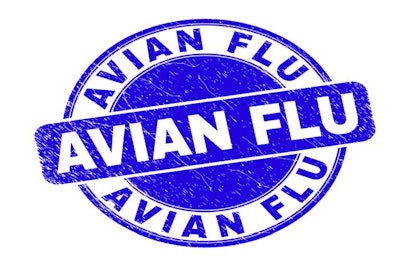
Within Europe, recently reported outbreaks of highly pathogenic avian influenza (HPAI) in commercial poultry have occurred mainly in central states from Lithuania and Romania to Denmark and Germany. German data indicate that, while the H5N1 serotype remains dominant, there have been fluctuations in the dominance of different viral genotypes over the past few months.
Recently reported new HPAI cases appear to indicate a deterioration in the disease situation in Central European countries.
Not only have seven countries confirmed new outbreaks in this population over the past 10 days, but there is evidence of the virus’s continued evolution. Despite this, all the poultry tested over this period were positive for the H5N1 virus serotype.
In its latest HPAI risk assessment for Germany, the national veterinary reference laboratory, Friedrich-Loeffler Institute (FLI) notes that there were nine HPAI outbreaks linked to the H5 virus “family” during the month of January. Affected were four farms with laying hens, one with meat turkeys, and four backyard flocks. Additionally, 31 cases were identified in the wild bird population.
Since November of 2023, four new HPAI virus genotypes have been detected in Germany, according to the FLI. An earlier subtype has been absent since September, while two variants have dominated in the country’s wild and domestic bird populations in December and January.
Rapid evolution by viruses may be associated with increased risks of their transmission and/or disease severity.
HPAI cases in 12 European states so far this year
Since the start of 2024, a total of 68 outbreaks of HPAI have been recorded on commercial farms in 12 European countries, according to the European Commission (EC; as of February 2). Its Animal Disease Information System covers the disease situation in European Union (EU) member states and neighboring countries.
Since the previous update dated January 27, this represents an increase of 14 outbreaks. Furthermore, first cases of the year have been confirmed in the Czech Republic (Czechia).
Of the most recent outbreaks, five were in Moldova, three in Poland, two in the Czech Republic and Denmark, and one in each of Germany and Slovakia.
Recent cases on poultry farms in 6 countries
Further information on recent outbreaks is included in the official notifications from the national veterinary authorities to the World Organisation for Animal Health (WOAH).
Over the past 10 days, these reports outline seven further outbreaks on Poland’s poultry farms, directly impacting just over 140,000 commercial birds. These bring the number of poultry affected in the country since January 1 to 323,106 at 13 premises across nine provinces.
In two north German states, presence of the H5N1 HPAI virus has recently been confirmed to WOAH on three farms — two with meat turkeys, and one with laying hens.
Furthermore, FLI reports that a turkey has recently tested positive for the virus in Cologne. This appears to be the first positive finding in the state of North Rhine-Westphalia since mid-December.
Over the past month, six outbreaks linked to the same virus variant have been confirmed in Denmark. Directly impacted have been more than 155,600 poultry in total at four premises on Zealand, and two in Jutland. Three of these infections were confirmed during the first week of this month.
Based on notifications to WOAH, there have been two further HPAI outbreaks involving poultry farms in the Czech Republic. Bringing the nation’s total for the year so far to three, latest to be affected were around 20,000 broiler breeders, and 49,000 fattening ducks.
Also officially registering two more farm outbreaks is Slovakia. Here, outbreaks in two broiler breeder flocks raised the nation’s total to three — all in different regions.
A fourth H5N1 outbreak of 2023 has been confirmed in the central Bulgarian province of Plovdiv, according to a recent official notification.
Meanwhile, the nation’s veterinary agency has declared to WOAH that an earlier outbreak wave linked to an unspecified H5 virus has been “resolved.” This involved 1.25 million poultry on eight farms across several provinces between October and December of last year.
6 states record new cases in captive birds
Based on the EC System, veterinary agencies of five European nations have so far confirmed HPAI cases in this category so far this year.
Including non-commercial poultry, zoos, and similar premises, the total has reached 27 (to February 2). This is one more than in the previous update, with Germany’s total increasing to five. Thirteen of the outbreaks have occurred in the Czech Republic.
Over the past 10 days, the authority in Moldova has notified WOAH about four more HPAI outbreaks in backyard flocks. Further notifications confirm cases at three premises with hobby flocks in the Czech Republic, and one each in Austria, Denmark and Ukraine.
Further HPAI cases in wild birds, other animals across Europe
As of February 2, 20 European countries had registered infections in their respective wild bird populations with the EC. This figure is unchanged from the previous update dated January 27, although the outbreak total has risen by 25 to 145.
Of the total, 37 have been reported by Germany, 18 by Denmark, 13 by Romania and 12 by Sweden. For each of the other countries, the total does not exceed eight.
Meanwhile, first cases of the year in this category have been reported to WOAH by Bosnia-Herzegovina, Lithuania, and the south Ukrainian province of Odesa.
Around mid-January, a red fox tested positive for the H5N1 HPAI virus in southwestern Germany. Found in the Karlsruhe area in Baden-Wurttemberg, this was the first infection in a non-avian species in Germany for several months.
View our continuing coverage of the global avian influenza situation.


















